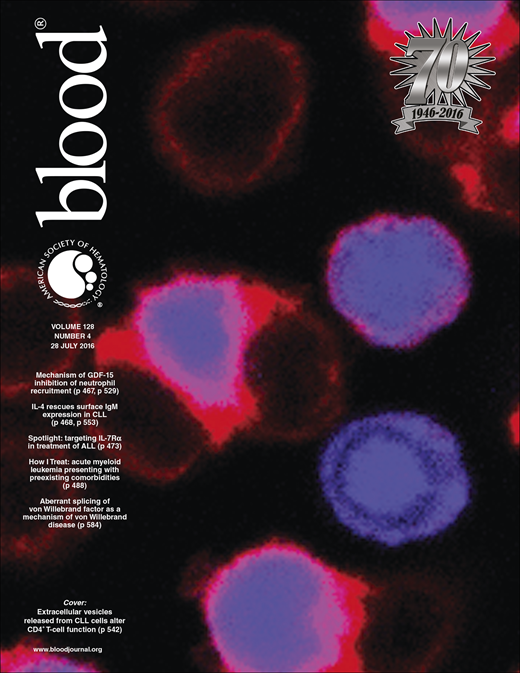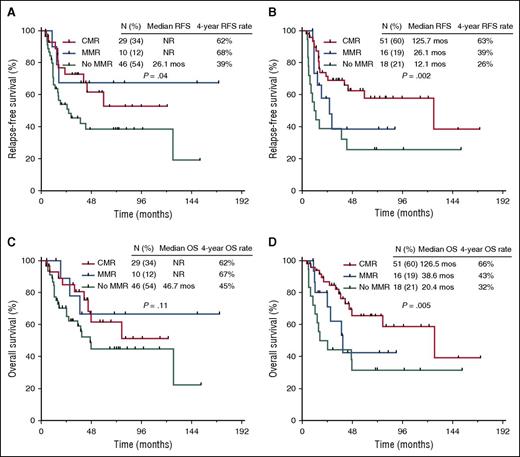Key Points
In patients with Ph+ ALL, achievement of CMR at 3 months is independently associated with improved survival.
CMR at 3 months may identify patients with Ph+ ALL who have excellent long-term outcomes without SCT in first CR.
Abstract
The impact of achieving complete molecular response (CMR) in Philadelphia chromosome-positive (Ph+) acute lymphoblastic leukemia (ALL) remains undefined. We evaluated the impact of CMR on outcomes among 85 patients with Ph+ ALL who received first-line hyperfractionated cyclophosphamide, vincristine, doxorubicin, and dexamethasone alternating with methotrexate and high-dose cytarabine plus a tyrosine kinase inhibitor, had minimal residual disease (MRD) assessments for BCR-ABL1 by quantitative polymerase chain reaction at complete remission (CR) and at 3-month time points, and did not undergo allogeneic stem cell transplantation (SCT). MRD status at 3 months had better discrimination for overall survival (OS; P = .005) and relapse-free survival (RFS; P = .002) than did MRD status at CR (P = .11 and P = .04, respectively). At 3 months, achievement of CMR vs response less than CMR was associated with longer median OS (127 vs 38 months, respectively; P = .009) and RFS (126 vs 18 months, respectively; P = .007). By multivariate analysis, only CMR at 3 months was prognostic for OS (hazard ratio, 0.42; 95% confidence interval, 0.21-0.82; P = .01). Patients with Ph+ ALL who achieve CMR at 3 months have superior survival compared with those with lesser molecular responses and have excellent long-term outcomes even without SCT.
Introduction
Assessment of minimal residual disease (MRD) has emerged as a powerful prognostic tool for patients with acute lymphoblastic leukemia (ALL).1-4 In patients with Philadelphia chromosome–negative (Ph–) ALL, MRD assessment can identify patients more likely to benefit from stem cell transplantation (SCT) in first complete remission (CR1).5 However, the utility of MRD monitoring in patients with Ph+ ALL is less defined.6 In individual studies of chemotherapy plus a tyrosine kinase inhibitor (TKI) in patients with ALL, deeper molecular responses, as assessed by quantitative polymerase chain reaction for the BCR-ABL1 transcript have been associated with improved outcomes, suggesting that these patients may represent a group with better prognosis in whom SCT in CR1 may be avoided.7-9 In addition, our previous retrospective analysis of patients receiving chemotherapy plus either imatinib or dasatinib who did not undergo SCT in CR1 found that achievement of at least a major molecular response (MMR) was independently prognostic for improved survival.10 To expand upon these findings, we sought to investigate the prognostic impact of achieving a complete molecular response (CMR) in adult patients with Ph+ ALL receiving first-line chemotherapy plus a TKI and compare that with lesser responses.
Study design
Patients
Between April 2001 and December 2015, 202 consecutive adult patients with previously untreated Ph+ ALL received induction with hyperfractionated cyclophosphamide, vincristine, doxorubicin, and dexamethasone alternating with methotrexate and high-dose cytarabine (the hyper-CVAD) regimen plus a TKI at our institution.11-13 The TKI was continued indefinitely as maintenance therapy. CR was achieved in 196 patients (97%), of whom 122 had MRD assessment for BCR-ABL1 by quantitative polymerase chain reaction at both CR and 3 months, as previously described.10 Thirty-seven patients who underwent SCT in CR1 were excluded, leaving 85 patients evaluable for this analysis. Twenty-three patients (27%) received imatinib, 39 (46%) received dasatinib, and 23 (27%) received ponatinib. CR was achieved after 1 cycle of therapy in 98% of patients; only 2 patients required 2 cycles to achieve CR. Median duration of survivor follow-up was 44 months (range, 5-171 months). The treatment protocols were approved by the MD Anderson Cancer Center Institutional Review Board. Informed consent was obtained according to the Declaration of Helsinki and our institutional guidelines.
Response definitions
CMR was defined as the absence of a detectable BCR-ABL1 transcript with a sensitivity of 0.01%. MMR was defined as a BCR-ABL1:ABL1 ratio ≤0.1% on the International Scale for p210 BCR-ABL1 or a 3-log reduction in transcripts for p190 BCR-ABL1, but not meeting criteria for CMR. Relapse was defined by recurrence of ≥5% blasts in a bone marrow aspirate or by the presence of extramedullary disease. Relapse-free survival (RFS) was calculated from the time of CR until relapse or death. Overall survival (OS) was calculated from the time of treatment initiation until death.
Statistical methods
RFS and OS were calculated by using Kaplan-Meier estimates, and survival estimates were compared by using the log-rank test. Univariate Cox proportional hazards regression models were used to assess the association between patient characteristics and RFS or OS. Patient characteristics with P < .10 in the univariate models were included in the multivariate model; backward elimination was used until all predictors had a P < .05.
Results and discussion
Baseline characteristics are summarized in supplemental Table 1, available on the Blood Web site. Molecular response at CR was CMR in 29 patients (34%), MMR in 10 (12%), and less than MMR in 46 (54%); molecular response at 3 months was CMR in 51 patients (60%), MMR in 16 (19%), and less than MMR in 18 (21%). Among patients with MMR at CR, 9 (90%) of 10 achieved CMR by 3 months compared with only 14 (30%) of 46 patients with less than MMR at CR. CMR rate at CR for patients receiving imatinib, dasatinib, or ponatinib was 22%, 31%, and 52%, respectively (P = .25); CMR rate at 3 months was 39%, 54%, and 87% for patients receiving each TKI, respectively (P = .001).
MRD status at 3 months had better discrimination for OS (P = .005) and RFS (P = .002) than did MRD status at CR (P = .11 and P = .04, respectively; Figure 1A-D). At CR, OS or RFS did not differ between patients who achieved CMR and those with a lesser response (P = .26 and P = .15, respectively). A univariate analysis of factors predictive for RFS and OS is shown in Table 1. At 3 months, patients who achieved CMR had significantly longer median OS and RFS compared with those with a lesser response (127 vs 38 months: hazard ratio [HR], 0.42 [95% confidence interval [CI], 0.21-0.82]; P = .01; and 126 vs 18 months: HR, 0.43 [95% CI, 0.21-0.78]; P = .01, respectively). Twelve (24%) of 51 patients with CMR at 3 months experienced relapse with a median time to relapse of 16 months (range, 10 to 59 months); 10 of these patients subsequently achieved remission with salvage therapy, and 5 underwent SCT in CR2. The 4-year OS and RFS rates for patients with CMR at 3 months were 66% and 63%, respectively. Only 2 deaths occurred after 4 years, both in patients who achieved CMR: 1 patient treated with dasatinib who relapsed with isolated central nervous system disease 5 years after initial diagnosis and subsequently died as a result of post-SCT infectious complications and 1 patient treated with imatinib who died as a result of infection while in CR 10 years after initial diagnosis. Of the 7 patients who did not achieve CMR at 3 months and who were still alive without relapse at 4 years, all eventually achieved CMR with a median time to CMR of 14 months (range, 8-87 months). Among the 51 patients who achieved CMR at 3 months, there was no impact on either OS or RFS according to TKI received (P = .22 and P = .40, respectively) or molecular response at CR (P = .76 and P = .85, respectively). By multivariate analysis, only the presence of Ph alone vs Ph plus other chromosomal abnormalities (HR, 0.42; 95% CI, 0.19-0.93; P = .03) and CMR at 3 months (HR, 0.41; 95% CI, 0.21-0.82; P = .01) were prognostic for RFS, and only CMR at 3 months was prognostic for OS (HR, 0.42; 95% CI, 0.21-0.82; P = .01).
Patient outcomes based on molecular response. Relapse-free survival by molecular response at (A) complete remission and (B) 3 months. OS by molecular response at (C) complete remission and at (D) 3 months. NR, not reached.
Patient outcomes based on molecular response. Relapse-free survival by molecular response at (A) complete remission and (B) 3 months. OS by molecular response at (C) complete remission and at (D) 3 months. NR, not reached.
These findings suggest that patients with Ph+ ALL treated with first-line chemotherapy plus a TKI who achieve CMR by 3 months have excellent long-term survival, which is independent of any baseline factors or the TKI received. Among this cohort of patients who did not receive SCT in CR1, the 4-year OS rate for patients achieving CMR by 3 months was 66% and median OS was more than 10 years. The long-term survival for these patients compares very favorably to the historical survival rate of patients with Ph+ ALL.6,14 Although these promising outcomes for this subgroup raise questions about whether SCT in CR1 can be safely avoided in these patients, definitive conclusions are limited because of potential bias that may have influenced which patients were referred to SCT in CR1.
CMR rates vary on the basis of which TKI is added to chemotherapy, ranging from 28% to 50% with imatinib,7,15,16 45% to 65% with dasatinib,9,12 and 78% with ponatinib,13 and the survival rates achieved seem to be better with each successive generation of TKI, although no randomized trials have yet been performed to confirm this observation. In our cohort, the CMR rate at 3 months in patients who received ponatinib was more than twofold that of patients who received imatinib. Although it is possible that the optimal timing of MRD assessment may vary across TKIs because of their varying potencies and different kinetics of leukemic burden reduction, these results nevertheless suggest that the impressive 2-year OS rate of 80% recently reported with hyper-CVAD plus ponatinib13 is likely mediated through the higher 3-month CMR rate achieved with this combination.
In conclusion, achievement of CMR at 3 months in patients with Ph+ ALL receiving first-line chemotherapy plus a TKI is associated with superior survival. Patients who do not achieve CMR and do not undergo SCT in CR1 have relatively poor outcomes. Prospective trials using MRD-based risk stratification for patients with Ph+ ALL may elucidate the optimal postremission management of these patients.
The online version of this article contains a data supplement.
The publication costs of this article were defrayed in part by page charge payment. Therefore, and solely to indicate this fact, this article is hereby marked “advertisement” in accordance with 18 USC section 1734.
Acknowledgment
This work was supported by National Institutes of Health/National Cancer Institute Cancer Center Support Grant CA016672 from the MD Anderson Cancer Center.
Authorship
Contribution: N.J.S. designed the study, collected and analyzed the data, and wrote the manuscript; E.J. and F.R. designed the study, collected and analyzed the data, treated patients, and wrote the manuscript; K.S. performed the statistical analysis; K.P. and R.L. performed the molecular analysis; H.K. designed the study, treated patients, and wrote the manuscript; and all authors (including S.M.O., J.E.C., R.G., G.C.I., G.G.-M., and D.T.) reviewed and approved the manuscript.
Conflict-of-interest disclosure: F.R., J.E.C., and H.K. received research funding from Bristol-Myers Squibb; J.E.C., E.J., and H.K. received research funding from Ariad Pharmaceuticals; F.R., J.E.C., E.J., and H.K. received research funding from Novartis Pharmaceuticals; and the remaining authors declare no competing financial interests.
Correspondence: Farhad Ravandi, The University of Texas MD Anderson Cancer Center, Department of Leukemia, Unit 428, 1515 Holcombe Blvd, Houston, TX 77030; e-mail: fravandi@mdanderson.org.
References
Author notes
N.J.S. and E.J. contributed equally to this study.



